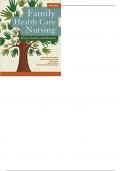Tentamen (uitwerkingen)
Family Health Care Nursing Theory Practice 5 Ed by Joanna Rowe Kaakinen, Deborah Padgett Coehlo - Test Bank
Test Bank For Family Health Care Nursing Theory Practice 5 Ed by Joanna Rowe Kaak
Complete Test Bank
[Meer zien]
Voorbeeld 4 van de 333 pagina's
Geupload op
25 november 2023
Aantal pagina's
333
Geschreven in
2022/2023
Type
Tentamen (uitwerkingen)
Bevat
Vragen en antwoorden
family health care nursing theory practice
test bank
complete test bank with answers
test bank for family health care
Instelling
Family Health Care Nursing
Studie
Family Health Care Nursing
Vak
Family Health Care Nursing
Alle documenten voor dit vak (10)
,Rowe Kaakinen, Family Health Care Nursing, 5e 1




